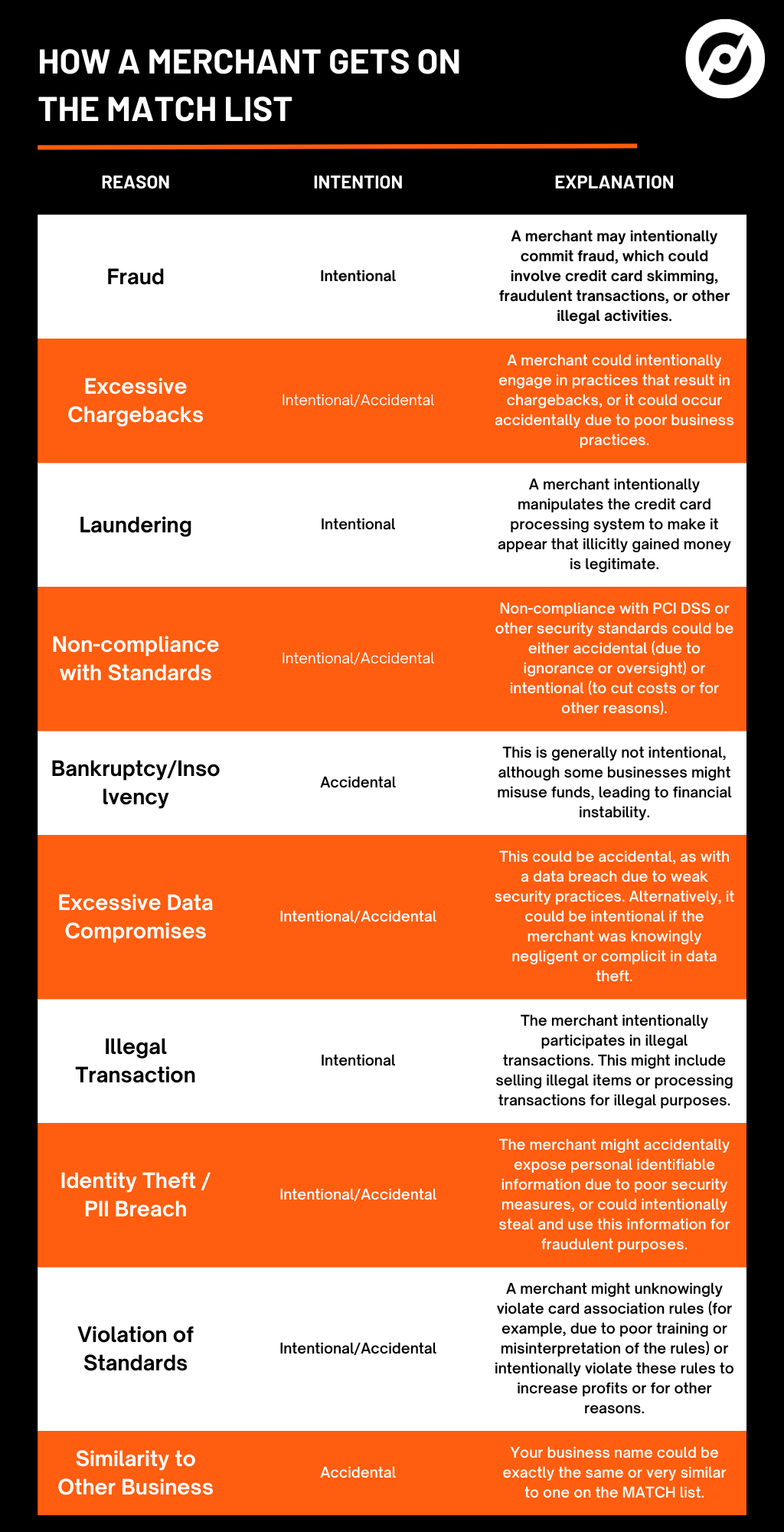
How to Get Off MATCH: A Guide
Jul 31, 2023 3 minutes
Stuck on MATCH and don’t know how you got there or how to get off? In this guide, we’ll take you through the step-by-step process of escaping from MATCH’s clutches and finally regaining your freedom.
Whether you’ve been placed on MATCH by accident, from a previous business, from a mismatch, or something else entirely, we’ve got all the insider tips and tricks that will help you navigate your way out.
What is the MATCH list and how does it work?
The MATCH list, also known as the Member Alert to Control High-Risk Merchants, is a tool used by banks and payment processors to identify high-risk merchants. It aims to protect consumers from fraudulent or unethical businesses.
- How does it work? When a merchant is flagged by the MATCH program, their information is shared with other banks and processors. This makes it difficult for them to open new accounts or process payments.
- What criteria are used? Merchants can be added to the MATCH list if they have a history of excessive chargebacks, fraud, money laundering, or violating card network rules.
- Can you appeal being on MATCH? Yes, but it’s not easy. To get off the list, you need strong evidence that shows your business has changed its practices and is no longer engaging in high-risk behavior.
Understanding how the MATCH program works can help you navigate through its challenges and take steps towards getting off this list.
How does a merchant end up on the MATCH list?
MATCH is a database used by financial institutions to help prevent fraud and money laundering. If you find yourself on MATCH, it’s essential to understand whether your placement was accidental or intentional.
Accidental Placement
Accidental placement may occur if there was an error in reporting information or if your identity was mistakenly linked to fraudulent activity. It could be due to a mix-up of personal details with someone else’s, such as similar names or addresses. By that, we mean when the processor or bank looked up your business name in the database, another one of the same name or something very similar appeared in the results and they assumed it was yours.
This is one of the main reasons why you might end up on MATCH without ever having opened a business before.
If you’ve never worked with the payment processor that’s put you on the MATCH list, it could be due to that bank being a partner of the processor that did put you on. For example, if Stripe put you on MATCH, it would likely show up as Wells Fargo since that is their partner bank.
Intentional Placement
Intentional placement, however, suggests that you have been involved in fraudulent activities knowingly. This could include issues like providing false documentation or engaging in illegal financial transactions.
Determining the reason behind your MATCH placement will help guide your strategy for getting off the list effectively. Whether accidental or intentional, addressing the root cause is crucial for success.

Chart with reasons why merchants are MATCH-listed.
Gathering Documentation and Evidence to Support Your Case
Before you can even think about getting off MATCH, you need to gather all the necessary documentation and evidence to support your case. This is crucial because without solid proof, it’s going to be an uphill battle. So roll up your sleeves and get ready to do some detective work!
- Start by reviewing your bank statements, receipts, and any other financial records that might help prove your innocence in whatever led you to being placed on MATCH.
- Don’t forget about communication records too! Gather emails, text messages, or anything else that could show important conversations with customers or clients.
- If there were any witnesses present during the incident in question, reach out to them for their statements or testimonials.
- It’s also a good idea to collect any relevant legal documents such as contracts or agreements that could provide additional context.
Remember: the more evidence you have on your side, the better chance you have of convincing the powers-that-be that you deserve another shot.
What Not To Do
While gathering documentation is essential for getting off MATCH successfully, there are a few things you should avoid doing:
- Fabricating evidence – this will only make matters worse if you get caught!
- Ignoring deadlines – make sure to stay organized and submit everything within specified time limits.
- Neglecting details – double-check every piece of information for accuracy before submitting it.
Once everything is collected and organized neatly into folders (both physical and digital), pat yourself on the back! You’re making significant progress towards freeing yourself from MATCH’s grip.
Contacting the Acquiring Bank or Payment Processor: Who to Reach out to and What to Say
Contacting the Acquiring Bank
When reaching out to the acquiring bank, it’s important to know who to contact and what to say. Start by gathering all relevant information about your MATCH listing, such as your merchant account number and reason for being placed on MATCH. This will help you when speaking with the bank representative.
Next, call the acquiring bank’s customer service line and ask to speak with someone in their risk or underwriting department. Clearly explain your situation, including your desire to get off MATCH and any steps you have taken to resolve the underlying issue. Maintain a calm and professional tone during the conversation.
Contacting the Payment Processor
If your acquiring bank is not able to assist you in getting off MATCH, it may be necessary to reach out directly to your payment processor. Ensure that you have all relevant information about your merchant account ready before making contact.
Start by calling their customer support line and ask for assistance regarding a MATCH listing. Explain that you are trying to resolve any issues causing your inclusion on MATCH, clarify any actions already taken, and emphasize your commitment towards complying with industry regulations moving forward.
Make sure to document all conversations held with both the acquiring bank and payment processor for future reference.
Crafting a Convincing Appeal Letter
Tips for Crafting a Convincing Appeal Letter
- Be clear and concise: Your appeal letter should clearly state your reasons for wanting to get off MATCH. Use simple language and avoid unnecessary jargon or complicated explanations.
- Provide supporting evidence: Back up your claims with relevant documentation. Include any receipts, bank statements, or other records that support your case.
- Show remorse and responsibility: Acknowledge any mistakes you may have made that led to being placed on MATCH. Express genuine remorse and explain what steps you have taken to prevent similar incidents in the future.
Following up with the Acquiring Bank—Persistence Pays Off!
Once you have submitted your MATCH resolution letter to the acquiring bank, it is important to follow up on a regular basis. Persistence in contacting the bank can increase your chances of getting off the MATCH list.
- Be proactive: Don’t wait for the acquiring bank to reach out to you. Take initiative and make regular phone calls or send emails to check on the progress of your case.
- Stay polite and professional: Remember that dealing with bureaucracy can be frustrating, but maintaining a respectful attitude will help build rapport with the bank staff.
- Document all interactions: Keep track of every conversation or email exchange with the acquiring bank. This documentation will serve as evidence if necessary.
- Include details such as date, time, name of contact person, and any commitments made during each interaction.
By persistently following up and maintaining good communication with the acquiring bank throughout this process, you are more likely to achieve success in getting off MATCH and regain access to merchant services.
Finding a Way Around MATCH with Alternative Payment Processing Solutions
When faced with the challenge of getting off MATCH, it’s important to explore alternative payment processing solutions. One option is to work with an offshore merchant account provider. These providers are located in countries where MATCH does not have jurisdiction, allowing businesses to bypass the system.
Another option is to find a high-risk merchant account provider that specializes in working with businesses on MATCH. These providers understand the challenges and risks associated with being on the list and may be able to offer solutions that other processors cannot.
It’s also worth considering using alternative payment methods, such as virtual wallets or cryptocurrency. These options typically have lower risk factors and are less likely to trigger matches.
Tips for Exploring Alternative Payment Processing Solutions:
- Research offshore merchant account providers located in jurisdictions outside of MATCH’s reach.
- Look for high-risk merchant account providers experienced in dealing with businesses on MATCH.
- Consider alternative payment methods like virtual wallets or cryptocurrency, which often have lower risk factors.
By exploring these options, businesses can find ways around MATCH and continue accepting payments without hinderance. However, it’s crucial to thoroughly research any new provider before making a decision and ensure they comply with all legal requirements and regulations.
Rebuilding Your Reputation: Strategies for Moving Forward After Getting Off MATCH
Once you have successfully removed your business from the MATCH list, it’s time to focus on rebuilding your reputation. Here are some strategies to help you move forward:
-
Apologize and make amends
Take responsibility for any mistakes or misconduct that led to your inclusion in the MATCH list. Offer a sincere apology to affected customers and assure them that changes have been made to prevent similar issues in the future. If possible, provide compensation or incentives as a gesture of goodwill.
-
Enhance customer service
One way to rebuild trust is by providing exceptional customer service. Train your employees to be polite, attentive, and responsive when dealing with customers’ concerns or complaints. Make sure processes are in place to address issues promptly and effectively.
-
Seek positive reviews
Encourage satisfied customers who have had positive experiences with your business since getting off MATCH to leave reviews online on platforms such as Google My Business or Yelp. Positive reviews can influence others considering whether or not they should give you their patronage.
Remember, rebuilding your reputation takes time and consistent effort; therefore, it’s essential not only initially but also continuously prioritize enhancing customer satisfaction as well as maintaining transparency within all aspects of running your business post-MATCH removal.




